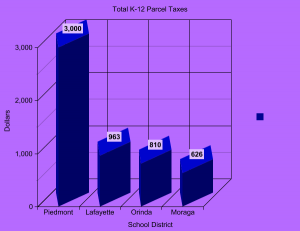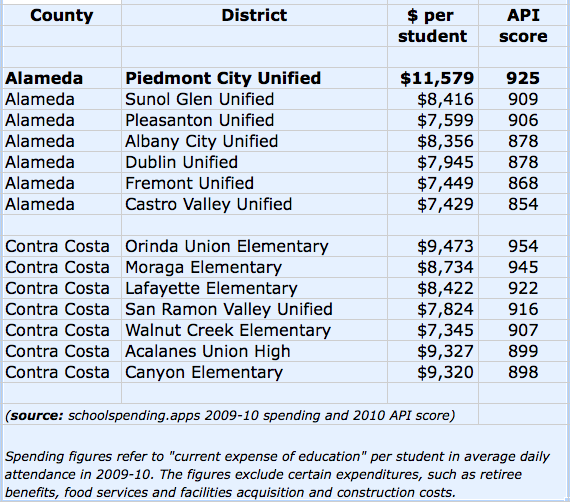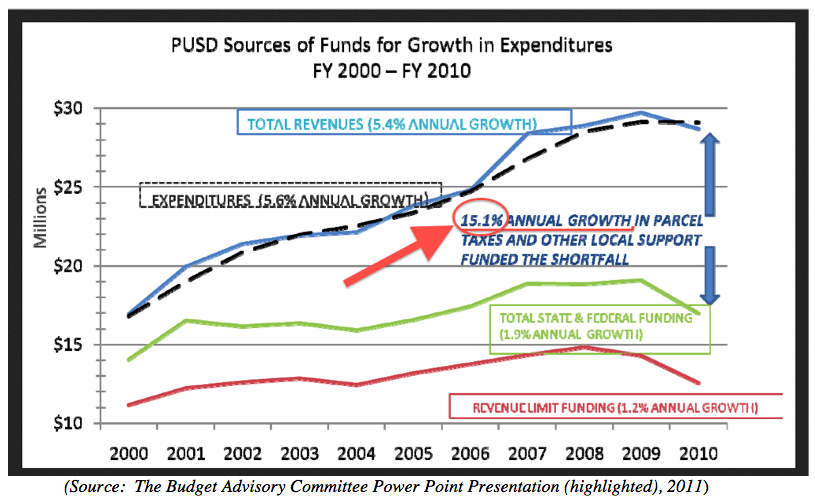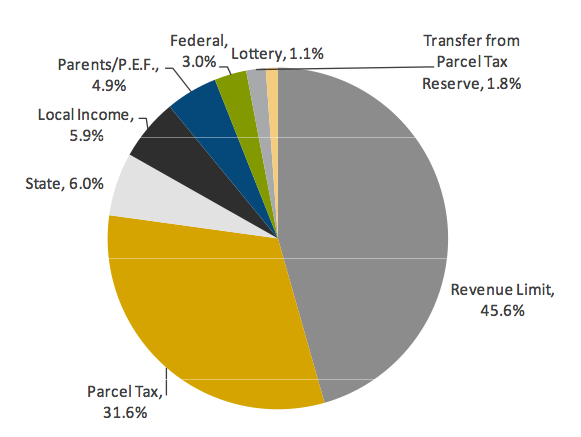Piedmont School Parcel Tax Facts (Part 2)
Part 2: A Close-Up Look at Piedmont School Finances
- Part 1: A $1 Million Problem – Temporary or Ongoing?
- Part 2: Piedmont Parcel Tax Facts
- Part 3: Piedmont Schools Face a Quandary
- Part 4: PUSD Deficit – $1 million or potentially $2.5 million
The Piedmont School Parcel Tax initiated in 1985 has been renewed 7 times. In 2000, twelve years ago, the tax generated $2.5 million (or $643 per home, if divided equally over Piedmont’s approximately 3885 parcels). As of 2012, the levy averages $3,000, with a minimum of almost $2,000 and a maximum of $3,400. generating $9 million. School parcel taxes for K-12 education in the 3 next most heavily taxed cities in Contra Costa and Alameda Counties are less than $1,000 per household.
Continued growth of the Piedmont School Parcel Tax at an annualized rate of 15% has been characterized as unsustainable by School Board Members in 2010 and by the Citizen’s Advisory Committee in 2011 (At p. 6).
 The School District Budget Advisory Committee, made up of representatives from each school
The School District Budget Advisory Committee, made up of representatives from each school, employee union representatives, administration and support groups, noted annualized growth of 15% between 2000 and 2010. A closer look reveals some of the facts behind this assessment.
Current Tax Levy: $1,989 to $3,379 per family
Voters in the town of Moraga rejected adding a proposed $225 to their current taxes of $626 in May, 2012. Total school parcel taxes in Orinda and Lafayette are $810 and $963 respectively. (All figures for these 3 cities include the parcel taxes of their high school District, Acalanes, in order to provide a K-12 comparison.) Moraga, Orinda, and Lafayette have a greater number of commercial parcels than Piedmont, but their school levies are the same for every type of parcel; commercial parcels do not generate more dollars than residential parcels, but generate fewer students. Hillsborough and Albany also levy less than $1,000 in school parcel taxes.
 $11,579 spending per student: $2,000-$3,000 more than Moraga, Orinda and Lafayette
$11,579 spending per student: $2,000-$3,000 more than Moraga, Orinda and Lafayette
The above chart shows 2009/10 Piedmont spending was $11,579 per student. Districts with similar API scores, Moraga, Orinda, Lafayette, and Acalanes Unified School Districts spend $2,000 to $3,000 per student less.
Applying the Moraga/Orinda/Lafayette/Acalanes spending ratio would result in a $5 million spending reduction by the Piedmont School District. (School districts with API scores less than 850 are not included in the chart.)
Projected Piedmont spending per student in 2013/14 is $11,546. If Proposition 30 is not approved by voters, Piedmont’s revenues projections will be reduced by about $441 per student since the PUSD included the threatened funds in their original projections.
Total Piedmont School Parcel Tax Revenue: 140% more than Moraga, 50% more than Orinda
Revenue generated by Piedmont residents for the schools is greater than nearby areas with similar property values. Despite a small population, Piedmont taxpayers currently generate $8.9 million in total parcel tax revenues. This amount is equivalent to Lafayette, a district with twice the population. It is 50% more than Orinda, a district with 67% more residents. It is 140% more than Moraga, a district with 50% more residents. (See chart above.)
Tax Growth: Annualized growth of 15% per year
As of 2000, the Piedmont school parcel tax generated $2.5 million. Current parcel tax revenue of $8.9 million in 2012-13 represents a 240% increase over the past 12 years, and an annualized increase of 20% per year. A 2010 School District Budget Advisory Committee (BAC) chart confirms local Piedmont parcel taxes “and other local support” grew at an annualized rate of 15% per year from 2000 to 2010, before further tax increases which occurred in 2011/12 and 2012/13. (See chart above.)
The school parcel tax offset both increasing expenditures for salaries and benefits and declining growth in state revenues. The school district levied increasing parcel taxes to fill the gap and avoid program or personnel adjustments.
Annual 5% Increases Permitted – Interim annual increases of 5% per year imposed by the School Board have contributed to Piedmont’s rapid parcel tax growth. In 2009. Measure B campaign leaders specifically advised supporters to tell residents that “Measure B will NOT increase your taxes”. Campaign literature FAQs asserted: “What you pay now is what you’ll pay if Measure B passes — your taxes will not increase.” The measure guaranteed no increase during the first year of its 4-year term; however, the School Board exercised its right to levy maximum increases in 2011/12 and 2012/13: 5% each year. In addition, the 2009 measure built upon 3 past 5% annual increases by the School Board since the last (2005) voter-approved measure.
With one exception, the school parcel taxes in Moraga (1), Orinda (2), Acalanes (2), and Lafayette (3) are flat parcel taxes – with no annual increases permitted. The exception, one of Lafayette’s school parcel taxes, permits annual increase of 3% per year, compared to Piedmont’s 5%. Compounding increases magnify small interest rate differences: repeated maximum increases would lead to 12% tax growth over 5 years in Lafayette, but 20% in Piedmont – almost twice the growth rate.
Support: One-third of District spending
Ten years ago (in 2003) the parcel tax represented 12% of the district’s operating budget. In 2009 it was 31% (see pie chart). By 2011-12 it was 33%, according to the President of the school board and the Citizens’ Advisory Committee. (CAC report at p. 6.) Parent and Educational Foundation donations provide an additional 5% of local support. Remaining funding comes various from state and federal sources as shown in the pie chart.
No Exemption – Piedmont parcel taxes are levied on every parcel, with no exemption for seniors or low-income families provided. Acalanes School District and Lafayette provide an exemption to all seniors. Moraga and Orinda exempt low-income seniors. Hillsborough ($545), Albany ($704), and Alameda (varies) provide an exemption to all seniors.
Read More in this series of articles examining Piedmont School Finances:
- Part 1: A $1 Million Problem – Temporary or Ongoing?
- Part 2: Piedmont Parcel Tax Facts
- Part 3: Piedmont Schools Face a Quandary
- Part 4: PUSD Deficit – $1 million or potentially $2.5 million






Getting a bit far afield, of the 8 highest API ranked districts in the state with a school support tax (Manhattan Beach does not have a tax), ALL other districts have a senior exemption; only Piedmont does not include this exemption. This includes San Marino, a community very comparable to Piedmont with two flat taxes that total $1169, the 2nd highest in the state.